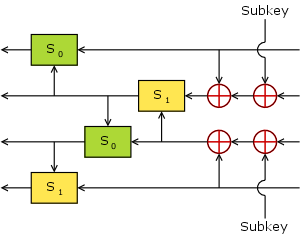Related Research Articles
In cryptography, a block cipher is a deterministic algorithm that operates on fixed-length groups of bits, called blocks. Block ciphers are the elementary building blocks of many cryptographic protocols. They are ubiquitous in the storage and exchange of data, where such data is secured and authenticated via encryption.

The Data Encryption Standard is a symmetric-key algorithm for the encryption of digital data. Although its short key length of 56 bits makes it too insecure for modern applications, it has been highly influential in the advancement of cryptography.
Differential cryptanalysis is a general form of cryptanalysis applicable primarily to block ciphers, but also to stream ciphers and cryptographic hash functions. In the broadest sense, it is the study of how differences in information input can affect the resultant difference at the output. In the case of a block cipher, it refers to a set of techniques for tracing differences through the network of transformation, discovering where the cipher exhibits non-random behavior, and exploiting such properties to recover the secret key.

In cryptography, the International Data Encryption Algorithm (IDEA), originally called Improved Proposed Encryption Standard (IPES), is a symmetric-key block cipher designed by James Massey of ETH Zurich and Xuejia Lai and was first described in 1991. The algorithm was intended as a replacement for the Data Encryption Standard (DES). IDEA is a minor revision of an earlier cipher, the Proposed Encryption Standard (PES).
In cryptography, Lucifer was the name given to several of the earliest civilian block ciphers, developed by Horst Feistel and his colleagues at IBM. Lucifer was a direct precursor to the Data Encryption Standard. One version, alternatively named DTD-1, saw commercial use in the 1970s for electronic banking.
In cryptography, Skipjack is a block cipher—an algorithm for encryption—developed by the U.S. National Security Agency (NSA). Initially classified, it was originally intended for use in the controversial Clipper chip. Subsequently, the algorithm was declassified.

The GOST block cipher (Magma), defined in the standard GOST 28147-89, is a Soviet and Russian government standard symmetric key block cipher with a block size of 64 bits. The original standard, published in 1989, did not give the cipher any name, but the most recent revision of the standard, GOST R 34.12-2015, specifies that it may be referred to as Magma. The GOST hash function is based on this cipher. The new standard also specifies a new 128-bit block cipher called Kuznyechik.

In cryptography, FEAL is a block cipher proposed as an alternative to the Data Encryption Standard (DES), and designed to be much faster in software. The Feistel based algorithm was first published in 1987 by Akihiro Shimizu and Shoji Miyaguchi from NTT. The cipher is susceptible to various forms of cryptanalysis, and has acted as a catalyst in the discovery of differential and linear cryptanalysis.

In cryptography, DES-X is a variant on the DES symmetric-key block cipher intended to increase the complexity of a brute-force attack. The technique used to increase the complexity is called key whitening.
In cryptography, Khufu and Khafre are two block ciphers designed by Ralph Merkle in 1989 while working at Xerox's Palo Alto Research Center. Along with Snefru, a cryptographic hash function, the ciphers were named after the Egyptian Pharaohs Khufu, Khafre and Sneferu.
In cryptography, LOKI89 and LOKI91 are symmetric-key block ciphers designed as possible replacements for the Data Encryption Standard (DES). The ciphers were developed based on a body of work analysing DES, and are very similar to DES in structure. The LOKI algorithms were named for Loki, the god of mischief in Norse mythology.
In cryptography, the eXtended Sparse Linearization (XSL) attack is a method of cryptanalysis for block ciphers. The attack was first published in 2002 by researchers Nicolas Courtois and Josef Pieprzyk. It has caused some controversy as it was claimed to have the potential to break the Advanced Encryption Standard (AES) cipher, also known as Rijndael, faster than an exhaustive search. Since AES is already widely used in commerce and government for the transmission of secret information, finding a technique that can shorten the amount of time it takes to retrieve the secret message without having the key could have wide implications.
In cryptography, the Cellular Message Encryption Algorithm (CMEA) is a block cipher which was used for securing mobile phones in the United States. CMEA is one of four cryptographic primitives specified in a Telecommunications Industry Association (TIA) standard, and is designed to encrypt the control channel, rather than the voice data. In 1997, a group of cryptographers published attacks on the cipher showing it had several weaknesses which give it a trivial effective strength of a 24-bit to 32-bit cipher. Some accusations were made that the NSA had pressured the original designers into crippling CMEA, but the NSA has denied any role in the design or selection of the algorithm. The ECMEA and SCEMA ciphers are derived from CMEA.
In cryptography, Madryga is a block cipher published in 1984 by W. E. Madryga. It was designed to be easy and efficient for implementation in software. Serious weaknesses have since been found in the algorithm, but it was one of the first encryption algorithms to make use of data-dependent rotations, later used in other ciphers, such as RC5 and RC6.
In cryptography, NewDES is a symmetric key block cipher. It was created in 1984–1985 by Robert Scott as a potential DES replacement.
In cryptography, a related-key attack is any form of cryptanalysis where the attacker can observe the operation of a cipher under several different keys whose values are initially unknown, but where some mathematical relationship connecting the keys is known to the attacker. For example, the attacker might know that the last 80 bits of the keys are always the same, even though they don't know, at first, what the bits are.
In cryptography, impossible differential cryptanalysis is a form of differential cryptanalysis for block ciphers. While ordinary differential cryptanalysis tracks differences that propagate through the cipher with greater than expected probability, impossible differential cryptanalysis exploits differences that are impossible at some intermediate state of the cipher algorithm.
This article summarizes publicly known attacks against block ciphers and stream ciphers. Note that there are perhaps attacks that are not publicly known, and not all entries may be up to date.
Michael Wood is an American cryptographer who designed the REDOC encryption system. He is also the author of The Jesus Secret and other books.

Speck is a family of lightweight block ciphers publicly released by the National Security Agency (NSA) in June 2013. Speck has been optimized for performance in software implementations, while its sister algorithm, Simon, has been optimized for hardware implementations. Speck is an add–rotate–xor (ARX) cipher.
References
- ↑ Bruce Schneier Applied cryptography: protocols, algorithms, and source code in C 1996 "REDOC III REDOC HI is a streamlined version of REDOC n, also designed by Michael Wood [1615]. It operates on an 80-bit block. The key length is variable and can be as large as 2560 bytes (20,480 bits). "
- Thomas W. Cusick and Michael C. Wood: The REDOC II Cryptosystem, CRYPTO 1990, pp545–563.
- Eli Biham and Adi Shamir, Differential Cryptanalysis of Snefru, Khafre, REDOC-II, LOKI and Lucifer. Advances in Cryptology – CRYPTO '91, Springer-Verlag, pp156–171 (gzipped PostScript).
- Ken Shirriff, Differential Cryptanalysis of REDOC-III, (PS)